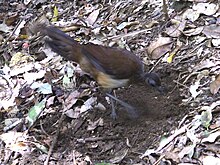Albert's lyrebird
| Albert's lyrebird | |
|---|---|
 |
|
| Scientific classification | |
| Kingdom: | Animalia |
| Phylum: | Chordata |
| Class: | Aves |
| Order: | Passeriformes |
| Family: | Menuridae |
| Genus: | Menura |
| Species: | M. alberti |
| Binomial name | |
|
Menura alberti Bonaparte, 1850 |
|
Albert's lyrebird (Menura alberti) is a timid, pheasant-sized songbird which is endemic to subtropical rainforests of Australia, in a small area on the state border between New South Wales and Queensland.
The rarer of the two species of lyrebirds, Albert's lyrebird is named after Prince Albert, the prince consort of Queen Victoria, queen of the United Kingdom. It lacks the elegant lyre-shaped tail feathers of the superb lyrebird and is found in a much more restricted range.
In the past, Albert's lyrebirds were shot to be eaten in pies, to supply tail-feathers to "globe-trotting curio-hunters" or by vandals.
The total population of Albert's lyrebirds is estimated at only 3,500 breeding birds and it has one of the smallest distributional ranges of any bird on the continent.
Albert’s lyrebird is a ground-dwelling bird with the female reaching approximately 75 cm in length and males 90 cm. They have a wingspan of 76–79 cm and weigh about 930 grams. They are chestnut-brown in colour with a rufous undertail, rump and throat. The bill is black; the iris dark brown or black, and it has a broad, blue-grey ring around the eye. The legs and feet are brownish grey to dark grey or black.
The sexes are alike except for the shape of the tail. The male has a spectacular tail composed of: (1) a central pair of long ribbon-like dark-brown median plumes; (2) six pairs of long, filmy and luxuriant filamentary feathers, which are black-brown above and dark grey below; and (3) a long broad fully webbed outermost pair of lyrates, which are black-brown above and dark grey below.
The tail of the female is shorter, simpler, slightly drooping and appears more pointed when closed; it is composed of a pair of long, narrow and tapered median plumes, and fully webbed broad brown feathers with rounded tips, but lacks filamentaries. When walking, the male carries its tail in an upward-curving train.
...
Wikipedia

